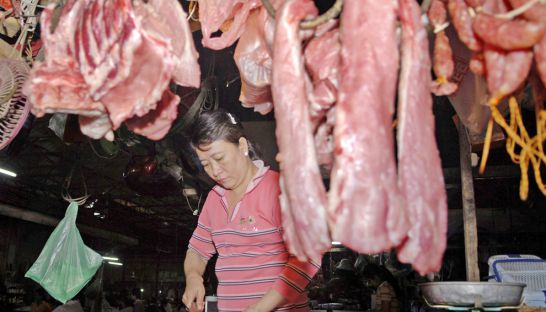Pig cull raises supply concerns
Pig cull raises supply concerns
Following a mass cull of more than 1,000 pigs over the last two weeks, authorities yesterday played down any threat to the local pork supply, but financial concerns among farmers and market vendors are mounting.

Some 1,200 pigs have been culled in Siem Reap, having recently found to be infected with Porcine Reproductive and Respiratory Syndrome. Commonly known as blue-ear pig disease, it is a viral condition that can cause reproductive failure and respiratory problems in pigs.
Tan Phannara, chief of the Animal Health Office at the Agriculture Ministry, said yesterday that there were no issues with pork shortages in Siem Reap and that prices were still stable, as the number of pigs destroyed is relatively low.
“The situation in the market seems to be okay, as I observe, because it doesn’t affect people’s health and there is no increased price as well,” Phannara said.
However, given that Pchum Ben – a 15-day festival where people pay respect to their ancestors – is a month away, Phannara said the ministry will try to balance out pork supply by increasing imports to supplement local meat.
“I think the price will be not higher for the supply in the upcoming Pchum Ben because instead of local supply we will also import supply. We try to stabilise the price by being flexible.”
Kouch Sokly, president of the Cambodia Restaurant Association and restaurant owner, said that while tainted pork could hit supplies during the Pchum Ben festival next month, he expected the Health Ministry to keep a check on the situation and alert businesses and customers if things become worse.
“It’s not serious yet. It is just a small portion in that area. It will not have much effect,” Sokly said.
“I think the Ministry of Health will take action if such a case happens. They will not allow it to affect people’s health.”
But customers have begun to inquire about whether pork sold in Siem Reap’s markets is affected by the disease, said Ming Mom, a pork seller in Old Market in Siem Reap.
“Before we sold three pigs per day, now we sell only two,” she said. “If the pigs continue to die we will have to go to other provinces to fill the demand.”
“The price depends on the farmer selling the pig. If they charge more, we will sell higher too.”
Srun Peu, deputy director of the Cambodia Pig Farmers Association, was more concerned about a further outbreak affecting the livelihoods of farmers, than he was about the local pork supply.
“I am not worried that there will be a shortage of supply of pork in Cambodia because the pork market always depends on the import from neighbouring countries,” Peu said.
“What I am worrying is the farmers who lose their pigs and become in debt, they might run away, or migrate to work in other countries.”
He added that there were concerns that the disease was spreading to Kandal province, with some pigs showing early signs of the illness.
Mouy Srey, a farmer in Chy Kreng district, Siem Reap, said she had already lost six pigs to the blue-ear pig disease, about a third of her swine. On a tight budget, the losses had put her on the back foot financially.
“I borrowed money from the bank, around $7,000, to raise pigs and ducks. But some pigs have died now and I will have to depend on the ducks.”














